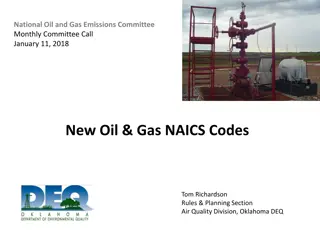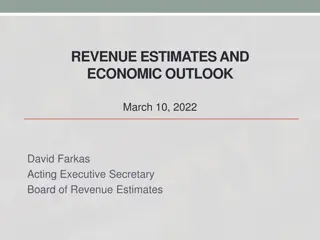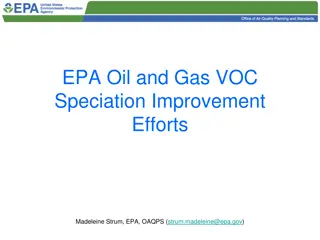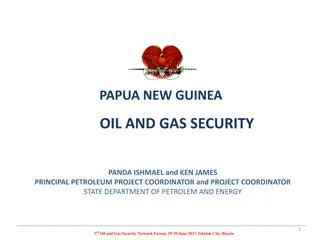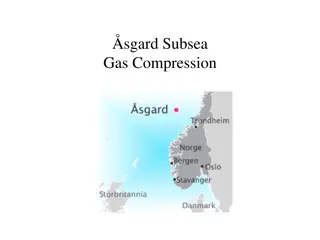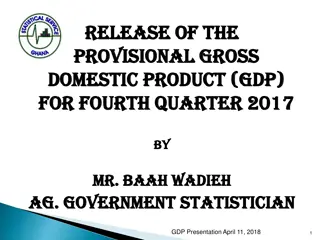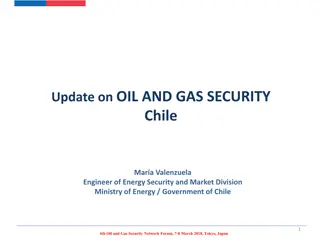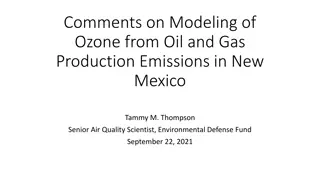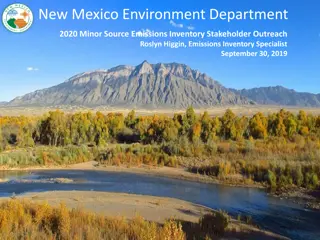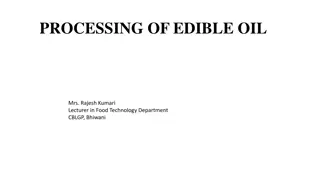Enhancing Oil and Gas Emissions Estimates for Area Sources
This presentation by Michael Ege, an Emissions Inventory Specialist at the Texas Commission on Environmental Quality (TCEQ), focuses on improving area source oil and gas emissions estimates. It covers the methods used to estimate emissions, including the development of basin-specific equipment profiles, utilization of survey and point source data, and the calculation of emissions at the county-level. The goal is to refine estimation processes and enhance accuracy in emission reporting for oil and gas operations.
Download Presentation

Please find below an Image/Link to download the presentation.
The content on the website is provided AS IS for your information and personal use only. It may not be sold, licensed, or shared on other websites without obtaining consent from the author. Download presentation by click this link. If you encounter any issues during the download, it is possible that the publisher has removed the file from their server.
E N D
Presentation Transcript
Improving Area Source Oil and Gas Emissions Estimates Michael Ege, Emissions Inventory Specialist Air Quality Division Texas Commission on Environmental Quality (TCEQ) 2017 International Emissions Inventory (EI) Conference Aug. 17, 2017
Overview Background information How area source emissions are estimated Oil and gas emissions submitted for the National Emissions Inventory (NEI) Texas oil and gas inventory milestones Development of tools/calculators used to estimate oil and gas emissions TCEQ Excel spreadsheet calculator Central States Air Resource Agencies (CenSARA) Excel spreadsheet calculator Environmental Protection Agency (EPA) Access database tool Air Quality Division Improving Area Source Oil and Gas Emissions Estimates MEE Aug. 17, 2017 Page 2
Overview (cont.) Developing basin-specific equipment profiles and emission factors Using survey data Using point source data Using EPA Greenhouse Gas Reporting Program (GHGRP) data Example: Updated compressor engine equipment profiles developed using GHGRP data Air Quality Division Improving Area Source Oil and Gas Emissions Estimates MEE Aug. 17, 2017 Page 3
How Area Source Emissions Are Estimated Emissions are estimated at the county-level Emissions = Activity x EF Activity Surrogate county-level data that is representative of the source being estimated Examples include: population, employment data, amount of fuel purchased, and number of oil and gas wells Emission Factor (EF) Generally, factors that are applied nation-wide Example: combustion factors from AP-42 Air Quality Division Improving Area Source Oil and Gas Emissions Estimates MEE Aug. 17, 2017 Page 4
How Area Source Oil and Gas Emissions Are Estimated For oil and gas sources, the equation is modified slightly: Emissions = Activity x EF x Equipment Profile Activity Emission Factor (EF) Equipment profile Number of pieces of equipment per well Operating parameters of equipment Amount of controls on equipment Goal: develop basin-specific equipment profiles to improve emission estimates Air Quality Division Improving Area Source Oil and Gas Emissions Estimates MEE Aug. 17, 2017 Page 5
Background Information Area source emissions are submitted for the NEI every three years Texas began estimating area source oil and gas emissions using well count and production activity data for the 2002 NEI The current Texas oil and gas calculator was developed in 2010, for the 2008 NEI Through the 2008 NEI, Texas was one of only a handful of states submitting area source oil and gas emissions for the NEI Air Quality Division Improving Area Source Oil and Gas Emissions Estimates MEE Aug. 17, 2017 Page 6
Background Information (cont.) Tools developed to help estimate oil and gas emissions TCEQ Excel spreadsheet calculator CenSARA Excel spreadsheet calculator EPA Access database tool For the 2014 NEI, Texas estimated oil and gas emissions for: 189,706 active oil wells 104,446 active gas wells Air Quality Division Improving Area Source Oil and Gas Emissions Estimates MEE Aug. 17, 2017 Page 7
Air Quality Division Improving Area Source Oil and Gas Emission Estimates MEE Aug. 17, 2017 Page 8
TCEQ Oil and Gas Calculator Developed by Eastern Research Group (ERG) in a 2010 TCEQ project, for the 2008 NEI Set of two Excel spreadsheet calculators By updating the activity data, Texas oil and gas inventories can be developed for different years by TCEQ staff Initially state-level equipment profiles A number of additional studies and projects have refined many equipment profiles and emission factors to the basin-level Air Quality Division Improving Area Source Oil and Gas Emissions Estimates MEE Aug. 17, 2017 Page 9
Texas Oil and Gas Basins and Shale Plays Air Quality Division Improving Area Source Oil and Gas Emissions Estimates MEE Aug. 17, 2017 Page 10
CenSARA Oil and Gas Calculator Based on the TCEQ calculator Developed by Environ in a 2012 CenSARA project, for the 2011 NEI Refined the equipment profiles and emission factors to the basin-level using survey data Focused on CenSARA states other than Texas (however, includes some Texas coverage since a few basins cross from neighboring states into Texas) For basins with no survey data, CenSARA average factors were developed Air Quality Division Improving Area Source Oil and Gas Emissions Estimates MEE Aug. 17, 2017 Page 11
EPA Oil and Gas Tool Based on the CenSARA calculator Developed by ERG in 2013 for the 2011 NEI An Access Database tool Used by EPA to estimate emissions for states that don t submit their own estimates Initially populated with basin-specific factors from CenSARA and TCEQ projects For other basins, populated with the CenSARA average factors as a default Air Quality Division Improving Area Source Oil and Gas Emissions Estimates MEE Aug. 17, 2017 Page 12
EPA Oil and Gas Tool (cont.) EPA encourages states to review the default factors, and to update the tool with state-specific factors Several states and regional organizations have provided area-specific updates For the 2014 NEI, ERG updated the tool with some basin-specific equipment profiles based on GHGRP data: Storage tank controls Pneumatic device counts Heater equipment profiles Compressor engine factors Continue to look for ways to update factors Air Quality Division Improving Area Source Oil and Gas Emissions Estimates MEE Aug. 17, 2017 Page 13
Developing Basin-Specific Equipment Profiles and Emission Factors To develop basin-specific factors, you need representative data Three common types of data used for oil and gas sources: Survey data Point source data GHGRP data Air Quality Division Improving Area Source Oil and Gas Emissions Estimates MEE Aug. 17, 2017 Page 14
Developing Basin-Specific Factors using Survey Data Obtain data directly from oil and gas operators through surveys Pros State-specific (and often basin-specific, or even county-specific) Represents actual real-world conditions Cons Time and cost intensive Difficult to get a high response rate Data can become outdated Question of whether there is enough data to be representative Air Quality Division Improving Area Source Oil and Gas Emissions Estimates MEE Aug. 17, 2017 Page 15
Examples of Texas Studies: Factors Developed from Survey Data 2014 Statewide Drilling Rig Emissions Inventory with Updated Trends Inventories (July 2015) Specified Oil and Gas Well Activities Emissions Inventory Update (August 2014) Hydraulic fracturing pump engines Mud degassing Upstream Oil and Gas Heaters and Boilers (August 2013) Air Quality Division Improving Area Source Oil and Gas Emissions Estimates MEE Aug. 17, 2017 Page 16
Examples of Texas Studies: Factors Developed from Survey Data (cont.) Condensate Tank Oil and Gas Activities (October 2012) Pneumatic Device surveys (2011 and 2012) Barnett Shale Special Inventory (2011) Compressor engines Piping component fugitives Characterization of Oil and Gas Production Equipment and Develop a Methodology to Estimate Statewide Emissions (Nov. 2010) Air Quality Division Improving Area Source Oil and Gas Emissions Estimates MEE Aug. 17, 2017 Page 17
Developing Basin-Specific Factors using Point Source Data Review data submitted by oil and gas operators Point source EI supporting documentation Permit supporting documentation Pros Large amount of data available for some basins Low (or no) cost Cons Can be time intensive, especially if the data is not in electronic format Reporting threshold: is data representative of area sources, or just the larger sources? Air Quality Division Improving Area Source Oil and Gas Emissions Estimates MEE Aug. 17, 2017 Page 18
Examples of Texas Factors Developed from Point Source Data Natural gas speciation and Volatile Organic Compound (VOC) content Derived from Glycol Dehydrator calculations Used the wet stream gas analyses to develop basin-specific speciation profiles These profiles are used for gas well piping fugitives, pneumatic devices, and mud degassing emissions estimates Condensate storage tank VOC emission factors and control factors Data taken from sample calculations Used to supplement survey data Air Quality Division Improving Area Source Oil and Gas Emissions Estimates MEE Aug. 17, 2017 Page 19
Developing Basin-Specific Factors using GHGRP data Review data submitted by oil and gas operators to the EPA GHGRP under Subpart W Pros Large amount of data available for many basins Mandatory reporting results in good response rate Data is current (2016 data will be available soon) Data is available for free on EPA s Envirofacts website Cons Reporting threshold: is data representative of all sources in a basin, or just the larger sources? Shale areas are not broken out and may skew the data Air Quality Division Improving Area Source Oil and Gas Emissions Estimates MEE Aug. 17, 2017 Page 20
Examples of Basin-Specific Factors developed from GHGRP data ERG-developed factors for the EPA tool Storage tank controls Pneumatic device counts Heater equipment profiles Number of compressor engines per gas well TCEQ-developed factors Storage tank controls (survey data supplemented by GHGRP data) Compressor engine horsepower (hp) sizes Air Quality Division Improving Area Source Oil and Gas Emissions Estimates MEE Aug. 17, 2017 Page 21
Updated Compressor Engine Profiles developed using GHGRP data Two types of basin-specific factors were developed: Number of compressors per gas well Average compressor engine hp sizes GHGRP data is available from EPA s Envirofacts website at: https://www.epa.gov/enviro/greenhouse-gas- customized-search Oil and gas data is available under Subpart W Petroleum and Natural Gas Systems Air Quality Division Improving Area Source Oil and Gas Emissions Estimates MEE Aug. 17, 2017 Page 22
GHGRP Data: Number of Compressors per Gas Well Data taken from table EF_W_EQUIP_LEAKS_ONSHORE Number of gas wellheads Number of compressors Adjustment made by TCEQ: removed data points where no compressors were reported (but gas wellheads were reported) GHGRP data is a subset of all oil and gas sources However, there were more gas wellheads reported in the GHGRP data than were present in the EPA tool for 10 out of 36 basins Appeared that some oil wellheads were mistakenly reported as gas wellheads Air Quality Division Improving Area Source Oil and Gas Emissions Estimates MEE Aug. 17, 2017 Page 23
GHGRP Data: Number of Compressors per Gas Well For most basins in Texas, the adjustments were minor: Compressors per gas wellhead original Compressors per gas wellhead adjusted Basin 220 - Gulf Coast Basin (LA TX) 260 - East Texas Basin 0.111 0.052 0.112 0.057 350 - South Oklahoma Folded Belt 360 - Anadarko Basin 400 - Ouachita Folded Belt 415 - Strawn Basin 420 - Fort Worth Syncline 425 - Bend Arch 430 - Permian Basin National average 0.381 0.156 0.316 0.247 0.182 1.047 0.050 0.077 0.381 0.156 0.316 0.248 0.182 1.047 0.051 0.087 Air Quality Division Improving Area Source Oil and Gas Emissions Estimates MEE Aug. 17, 2017 Page 24
GHGRP Data: Average Compressor Engine hp Sizes Data taken from three tables and merged using the GHGRP facility ID number EF_W_COMBUST_LARGE_UNITS Basin-wide fuel usage by compressor engines Carbon dioxide (CO2) emissions EF_W_RECIP_COMP_ONSHORE Number of compressor engines in each basin EF_W_INTRODUCTION_SUMM GHGRP facility ID number Basin associated with facility ID Air Quality Division Improving Area Source Oil and Gas Emissions Estimates MEE Aug. 17, 2017 Page 25
GHGRP Data: Average Compressor Engine hp Sizes (cont.) Important to do some quality assurance checks to ensure the data is reasonable Estimated CO2 emissions (based on fuel usage and AP-42 emission factors) were compared to reported CO2 emissions Two data points were 1000x too high One data point was 1000x too low Average hp size for each data point was estimated using default engine parameters hp s > 2500 appeared to be too high hp s < 25 appears to be too low Air Quality Division Improving Area Source Oil and Gas Emissions Estimates MEE Aug. 17, 2017 Page 26
GHGRP Data: Average Compressor Engine hp Sizes (cont.) Basin-level compressor engine runtimes were taken from the EPA tool Since 95% of the load factors were 0.75 or 0.76, a load factor of 0.75 was used to develop these hp sizes The GHGRP data was not subdivided into lean-burn and rich-burn engines, so average hp sizes were developed Using the hp size data from the EPA tool, the average hp sizes were ratioed to get updated lean-burn and rich-burn hp s Air Quality Division Improving Area Source Oil and Gas Emissions Estimates MEE Aug. 17, 2017 Page 27
GHGRP Data: Things to Consider The GHGRP data is reported at the basin- level for most source types Shale areas are not broken out from the basins, and can sometimes skew the data Some source types have data reported at the county-level, so it may be possible to develop separate factors for shale areas versus non-shale areas Example: TCEQ performed an in-depth review of storage tank controls, and was able to develop control factors for the Eagle Ford Shale area Air Quality Division Improving Area Source Oil and Gas Emissions Estimates MEE Aug. 17, 2017 Page 28
Storage Tanks Controls Comparison between EPA tool and TCEQ calculator storage tank control factors: EPA tool % controls TCEQ calculator % controls Oil storage tanks Western Gulf Basin 81.1 31.9 81.1* Eagle Ford Shale area 83.6 Condensate storage tanks EPA tool % controls TCEQ calculator % controls Western Gulf Basin 78.8 43.3 78.8* Eagle Ford Shale area 70.5 * The EPA tool does not break the Eagle Ford Shale area out of the Western Gulf Basin Air Quality Division Improving Area Source Oil and Gas Emissions Estimates MEE Aug. 17, 2017 Page 29
Project Reports posted on the TCEQ website Air Quality Research and Contract Reports can be found at: http://www.tceq.texas.gov/airquality/airmod/project /pj_report_ei.html Reports include: Growth Factors for Area and Point Sources 2014 Statewide Drilling Rig Emissions Inventory with Updated Trends Inventories Specified Oil and Gas Well Activities Emissions Inventory Update Upstream Oil and Gas Heaters and Boilers Condensate Tank Oil and Gas Activities Emission Factor Determination for Produced Water Storage Tanks Air Quality Division Improving Area Source Oil and Gas Emissions Estimates MEE Aug. 17, 2017 Page 30
Contact Information Michael Ege (512) 239-5706 Michael.Ege@tceq.texas.gov TCEQ area source Web page http://www.tceq.texas.gov/airquality/areasource Air Quality Division Improving Area Source Oil and Gas Emissions Estimates MEE Aug. 17, 2017 Page 31





